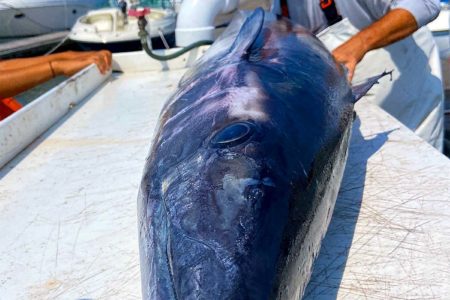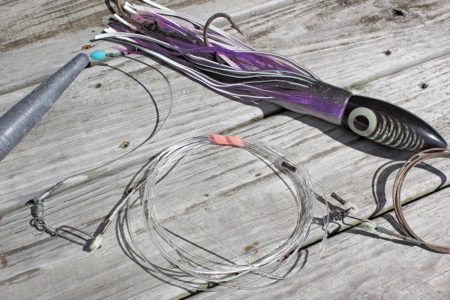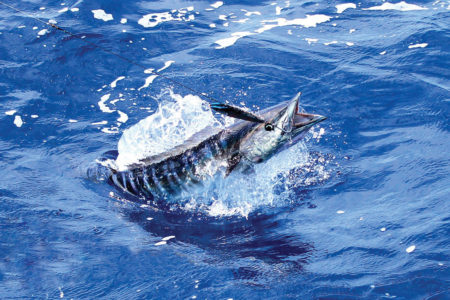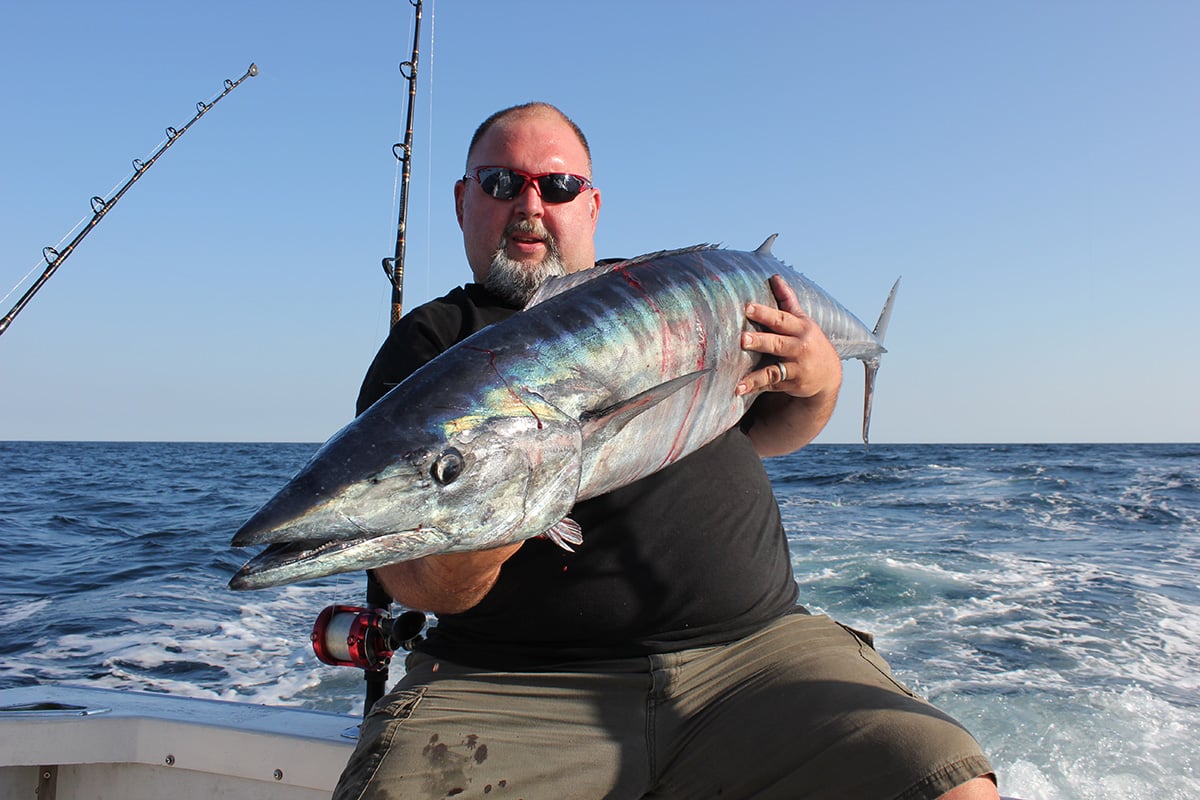
“You have got to be freaking kidding me,” was all I could think. For the second time that day we got cut off by a fish.
It was a weird bite, the rod barely bent over, and the line was cut clean at the leader. My crew aboard the Salty Lady nearly had me convinced it was bluefish, but I was still skeptical; the leader after all looked as if it were cut with a razor, no chafe, nothing but a clean cut. We were trolling bluefin on the 30-fathom line and fishing was tough, so any missed fish was a sore spot.
The following day I found myself in the same area just after sun up, still thinking about the fish that cut us off the previous day, when the starboard short rigger suddenly got smashed; the angler on the rod was a bit of a novice, so when he said he might run out of line I was a little dismissive. When my mate Ned looked up at the bridge and said “you better go,” I knew we were running short.
I cut the wheel and pushed the throttles and in no time, we were gaining on the fish; 20 minutes later I sunk the gaff into the biggest wahoo I had ever seen; I was smitten to say the least! It was all of 6 feet in length and girthy. The blues and chromes were stunning. At that moment, I realized that was probably what cut us off the day before.
Putting that fish onboard was an accident; my plan was for the next one not to be!
Speed Kills
A few winters back while on a shared offshore charter in the Bahamas, I’d climbed aboard hoping for billfish or tuna, but as the mate set out the lures, and the captain began accelerating well past our normal 6 knots settling in somewhere around a 15-knot trolling speed, I thought something might be amiss with my crew. As I sat in silence lamenting about the money “wasted” on this trip, the mate turned around and with a smile said, “We wahoo fishin’ now ‘mon.” Sure enough 15 minutes later a nice 30-plus-pound wahoo hit the deck; over the next few hours we boated nine more to about 40 pounds as I rattled off questions to the mate and studied the captain’s every move.
Flash forward a couple of years and it’s my first time aboard the Marlin Fever, a private vessel out of Beach Haven, NJ. We had hooked a few whites on the day and were thinking it may be time to wrap it up, until one of the owners said, “let’s wahoo fish on the ride home.” We set out a two-rod spread of bent butt 50 Penn internationals and bumped the speed from 5 to 14 knots, a bit of a Bahamas flashback. No kidding, it wasn’t 15 minutes later that the port rod began to peel line, and only 10 minutes later I sunk the gaff into a respectable 40-pound wahoo.
I consider myself a very logical angler, and I have a compulsive need to figure out why a spot or technique works on certain fish. This high-speed trolling technique was a bit of a conundrum. Best I can theorize is that much like a dog, when a lure screams past a ‘hoo at that speed its instinct kicks in and it has to attack. After all, if you want a dog to come to you, run from it. Same idea, and that is the theory I have adopted and explain to my clients and crew as to why this works. First I have to usually explain that I’m not crazy or just taking them for “a ride” (which was exactly what I thought on that first trip back in the Bahamas). Once armed with the theory, from that point forward I adopted high speed trolling as part of my arsenal, and many wahoos later, it is still producing.
The wahoo is found worldwide in tropical and subtropical seas; known in Hawaii as “ono” and “peto” in Central America, the wahoo is never misidentified with its long, torpedo shape, electric blue back, chrome belly and those unmistakable black bars along its flanks. One of the fastest sprinters in the ocean being clocked at speeds up to 60 mph, it’s no wonder why 14 knots isn’t too fast a trolling speed. And no matter where you catch the wahoo, all anglers agree it is an absolute delicacy; its white steaks are great on the grill or served as fish tacos.
In addition to speed, the ‘hoo has a second weapon, its jaws. The teeth of a wahoo are razor sharp on all sides, and the way that the top and bottom jaws are arranged they are like a pair of surgically sharp scissors. Care should be taken whenever handling a ‘hoo on deck; most like myself keep a billy club handy, and a few good hits to the head can really “calm” down a green wahoo on deck.
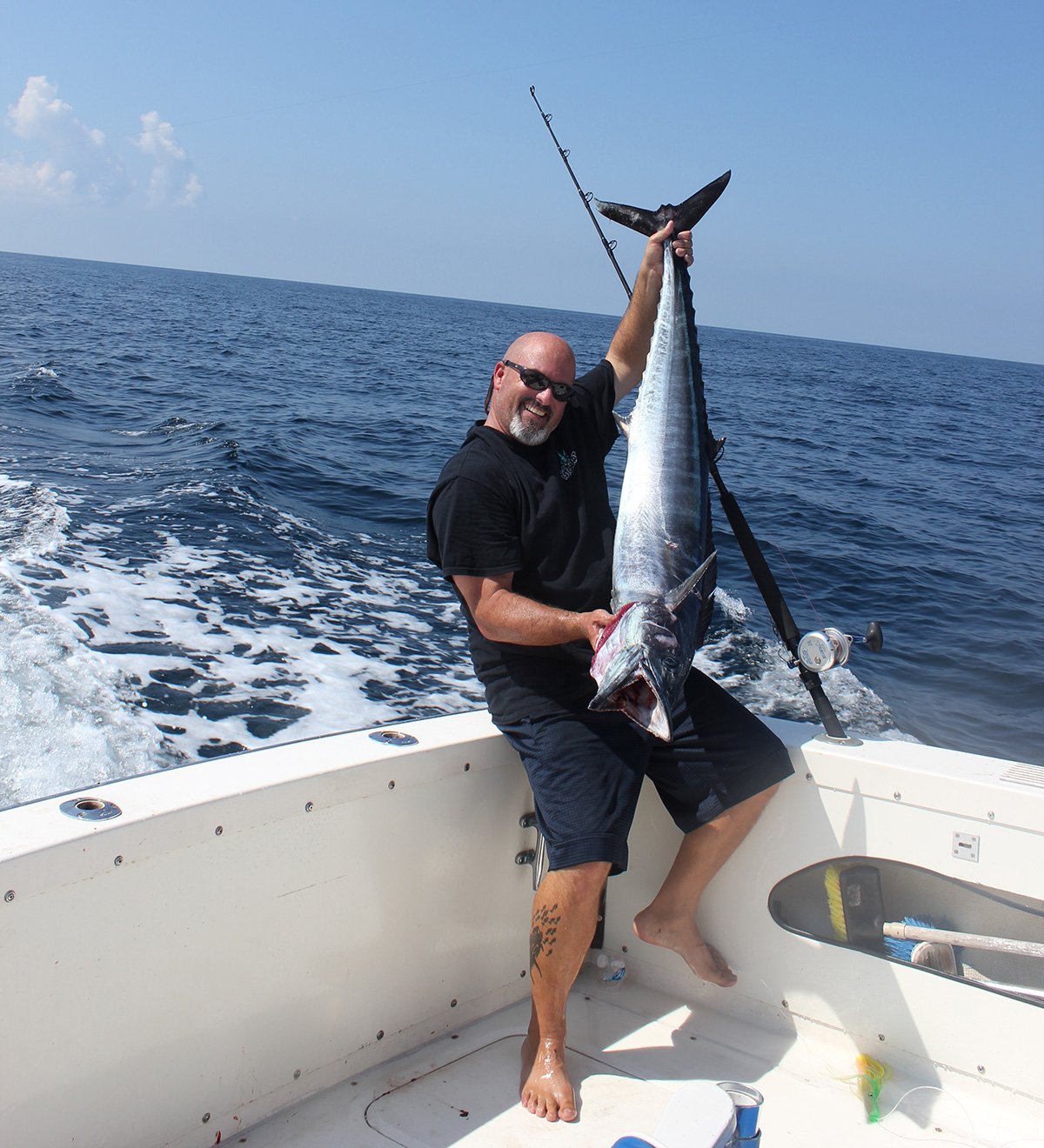
Cover the Spread
We run a two-rod spread for ‘hoos, any more and it could get ugly with tangles and rod clearing. Both rods are fished out of the left and right stern corner rodholders. As a caution, you may need to reinforce those holders under the gunnels, or use a line from the rod to an anchor point allowing some of the tension to be relieved from the holder. Fourteen knots create a lot of pressure on a gunnel mounted rodholder.
Reel wise, we use Accurate Boss BX2 30 class reels coupled with Connelly bent butt 50 class rods, but most boats employing this method use 50 class reels with matching rods. If you don’t have bent butts, no worries; I started out with straight butts as well, however, the straight butts do have a ton more pressure on them due to the angle of pull versus a bent butt. Whatever style of rod you use, lever drags reels are the key. Once at speed (12 to 15 knots) push the lever drags as far forward as needed to prevent the line from creeping out while trolling. This can be upwards of 25 pounds. Keep in mind this high of a drag setting places so much strain on the equipment, and it must be of top quality and in perfect working order.
Aboard the Salty Lady we rarely use rod tethers; but when we high speed troll, both rods get tethered to the fighting chair base, just in case. We fish lures only at these speeds, no baits (at these speeds is near impossible to keep a ballyhoo from peeling like a banana), and we fish the lures way back. In a two-rod spread, one lure is placed 100 to 150 yards back, and the other at least 150 yards back. Definitely stagger them to preserve turning ability without them tangling. Once we are ready to deploy the spread we bring our speed to 14 knots and set out!
One tip; at 14 knots the engine noise may very well drown out the sound of a screaming clicker, so we always place a rubber band on the main line just ahead of the reel. The band acts like a strike indicator, if the band is gone, fish on! It took a few spooled reels to come up with this one, trust me just use it.
Get Down on It
By now you must be wondering how to keep lures under the water at 14 knots? Simple answer is lead, and lots of it! Most days a 32-ounce trolling drail works well, but we have had to go to 64 ounces depending on conditions. We use wahoo trolling weights from Tournament Cable that have cable on both ends in various weights; and each loop is chaff guarded. With all this weight, speed, and tension, it also stands to reason that a shock leader should be part of this rigging system. A 10-foot-long, 250-pound test shock leader is standard for us. We rig it with a chaff guarded loop on one end and a quality 230-pound ball bearing snap swivel on the other. The loop end of the shock leader is connected to the trolling weight’s swivel, and the shock leader swivel is connected to the barrel swivel at the lure end. Total length of the rigging should be manageable at boat side, from 12 to 15 feet long.
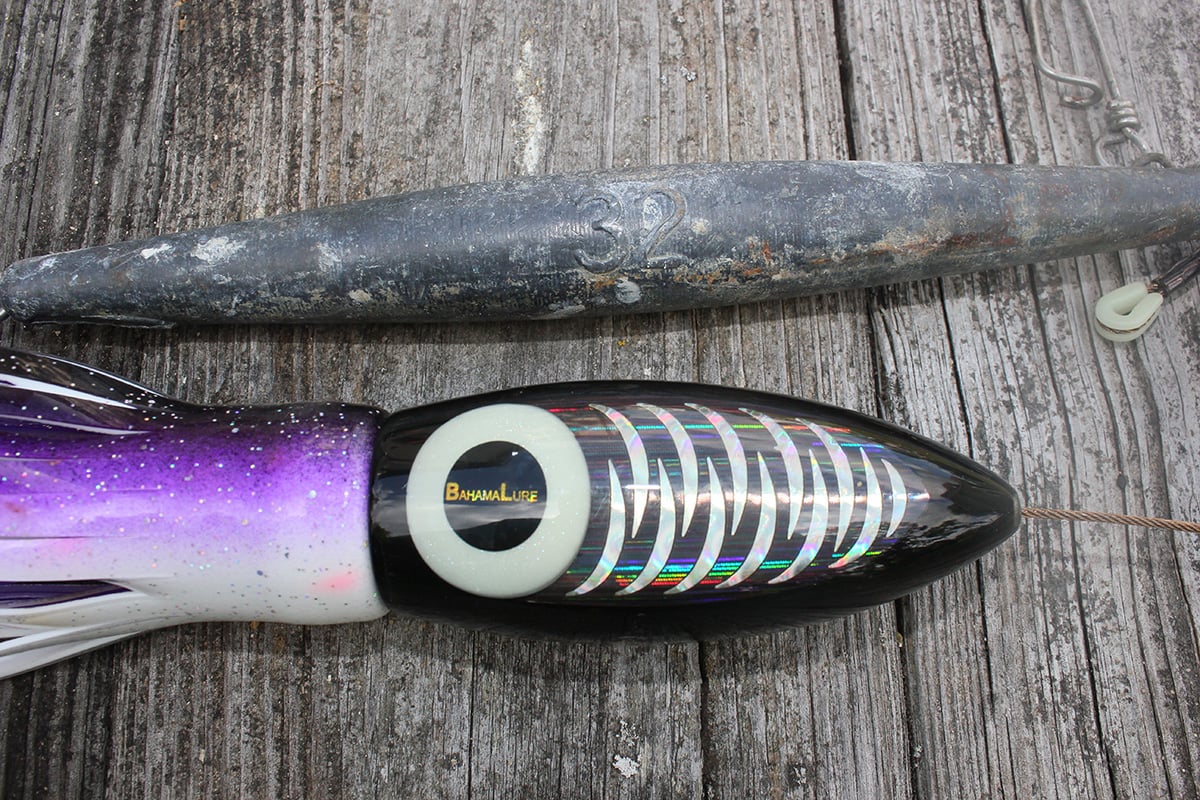
Finally comes lure selection; while I have no connection with the company whatsoever, I’d be remiss if I didn’t recommend my personal favorite, the Bahama Lures Proteus 50 in black and purple, which has outfished all my other wahoo lures like five to one. But, we have also taken fish on Ballyhood Cowbell lures and heavy headed bullet type lures. While black and purple are favorite colors, red and black have produced, as has orange. Big is okay here as well; most of our wahoo lures are at least 15 inches up to 18 inches in length.
Some wahoo lures come rigged, but we have found that certain rigging works better than others. We use 300-pound, 49-strand cable. With 5 feet of cable ahead of the lure’s head, crimp a loop with a ball bearing barrel swivel. As for the hooks, we crimp a double stiff rig, two 9/0 Mustad hooks in line with each other, placing the trailing hook just beyond the end of the skirt. It is very important to know that our hook up ratio is best when the hooks are allowed to ride point facing up in the lure. Electrical tape or hook keepers aid in keeping the hooks riding upward.
As for places to target these speedsters, along my home grounds off the Jersey Coast we’ll look at the traditional fish-holding areas like the “tails” and the flats before canyons; closer inshore, areas like the Fingers and Monster Ledge hold ‘hoo as well. Wherever you may be heading offshore, anywhere between the 20 fathom and 40 fathom line is worth a look, with areas with lumps, holes, wrecks or fingers all good places to focus attention. What is also very convenient is that you can drop in your ‘hoo spread when you’re approaching or leaving tuna locations, searching for bait or tuna, or my favorite, when you can’t do more than 15 knots anyway due to conditions!
One last tip, weed lines and large floating debris don’t just hold mahi, they usually hold wahoo deeper in the column and high speed trolling past these produces great results! While we rarely leave the dock targeting wahoo specifically, you can bet that we rarely go a day offshore without dedicating some of our time to targeting those hi speed ‘hoos, and you should too!
